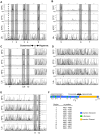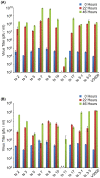High-resolution functional mapping of the venezuelan equine encephalitis virus genome by insertional mutagenesis and massively parallel sequencing
- PMID: 20976195
- PMCID: PMC2954836
- DOI: 10.1371/journal.ppat.1001146
High-resolution functional mapping of the venezuelan equine encephalitis virus genome by insertional mutagenesis and massively parallel sequencing
Abstract
We have developed a high-resolution genomic mapping technique that combines transposon-mediated insertional mutagenesis with either capillary electrophoresis or massively parallel sequencing to identify functionally important regions of the Venezuelan equine encephalitis virus (VEEV) genome. We initially used a capillary electrophoresis method to gain insight into the role of the VEEV nonstructural protein 3 (nsP3) in viral replication. We identified several regions in nsP3 that are intolerant to small (15 bp) insertions, and thus are presumably functionally important. We also identified nine separate regions in nsP3 that will tolerate small insertions at low temperatures (30°C), but not at higher temperatures (37°C, and 40°C). Because we found this method to be extremely effective at identifying temperature sensitive (ts) mutations, but limited by capillary electrophoresis capacity, we replaced the capillary electrophoresis with massively parallel sequencing and used the improved method to generate a functional map of the entire VEEV genome. We identified several hundred potential ts mutations throughout the genome and we validated several of the mutations in nsP2, nsP3, E3, E2, E1 and capsid using single-cycle growth curve experiments with virus generated through reverse genetics. We further demonstrated that two of the nsP3 ts mutants were attenuated for virulence in mice but could elicit protective immunity against challenge with wild-type VEEV. The recombinant ts mutants will be valuable tools for further studies of VEEV replication and virulence. Moreover, the method that we developed is applicable for generating such tools for any virus with a robust reverse genetics system.
Conflict of interest statement
The authors have declared that no competing interests exist.
Figures







Similar articles
-
Venezuelan Equine Encephalitis Virus nsP3 Phosphorylation Can Be Mediated by IKKβ Kinase Activity and Abrogation of Phosphorylation Inhibits Negative-Strand Synthesis.Viruses. 2020 Sep 13;12(9):1021. doi: 10.3390/v12091021. Viruses. 2020. PMID: 32933112 Free PMC article.
-
Structural and biophysical analysis of sequence insertions in the Venezuelan Equine Encephalitis Virus macro domain.Virus Res. 2015 Apr 2;201:94-100. doi: 10.1016/j.virusres.2015.02.018. Epub 2015 Feb 25. Virus Res. 2015. PMID: 25725151
-
Hypervariable domain of nonstructural protein nsP3 of Venezuelan equine encephalitis virus determines cell-specific mode of virus replication.J Virol. 2013 Jul;87(13):7569-84. doi: 10.1128/JVI.00720-13. Epub 2013 May 1. J Virol. 2013. PMID: 23637407 Free PMC article.
-
Mutations in Hypervariable Domain of Venezuelan Equine Encephalitis Virus nsP3 Protein Differentially Affect Viral Replication.J Virol. 2020 Jan 17;94(3):e01841-19. doi: 10.1128/JVI.01841-19. Print 2020 Jan 17. J Virol. 2020. PMID: 31694937 Free PMC article.
-
Current Understanding of the Molecular Basis of Venezuelan Equine Encephalitis Virus Pathogenesis and Vaccine Development.Viruses. 2019 Feb 18;11(2):164. doi: 10.3390/v11020164. Viruses. 2019. PMID: 30781656 Free PMC article. Review.
Cited by
-
Imaging of the alphavirus capsid protein during virus replication.J Virol. 2013 Sep;87(17):9579-89. doi: 10.1128/JVI.01299-13. Epub 2013 Jun 19. J Virol. 2013. PMID: 23785213 Free PMC article.
-
Genome-Wide Mutagenesis of Hepatitis C Virus Reveals Ability of Genome To Overcome Detrimental Mutations.J Virol. 2020 Jan 17;94(3):e01327-19. doi: 10.1128/JVI.01327-19. Print 2020 Jan 17. J Virol. 2020. PMID: 31723027 Free PMC article.
-
Controllable self-replicating RNA vaccine delivered intradermally elicits predominantly cellular immunity.iScience. 2023 Mar 5;26(4):106335. doi: 10.1016/j.isci.2023.106335. eCollection 2023 Apr 21. iScience. 2023. PMID: 36968065 Free PMC article.
-
The Putative Roles and Functions of Indel, Repetition and Duplication Events in Alphavirus Non-Structural Protein 3 Hypervariable Domain (nsP3 HVD) in Evolution, Viability and Re-Emergence.Viruses. 2021 May 28;13(6):1021. doi: 10.3390/v13061021. Viruses. 2021. PMID: 34071712 Free PMC article. Review.
-
Random Insertional Mutagenesis of a Serotype 2 Dengue Virus Clone.Bio Protoc. 2018 Aug 20;8(16):e2975. doi: 10.21769/BioProtoc.2975. Bio Protoc. 2018. PMID: 30214914 Free PMC article.
References
-
- Sawicki DL, Sawicki SG. Alphavirus positive and negative strand RNA synthesis and the role of polyproteins in formation of viral replication complexes. Arch. 1994;Virol(Suppl 9):393–405. - PubMed
-
- Griffin D. Knipe DM, Howley PM, editors. Alphaviruses. 2007. Fields Virology, 5th edition: Lippincott, Williams, and Wilkins.
Publication types
MeSH terms
LinkOut - more resources
Full Text Sources
Other Literature Sources

